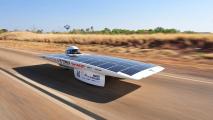A strange sound is coming from the rolling, clay-colored hills of Spain’s Aragón region — like the distant, hyper-whirring of a machine on the edge of burning out.
The fog mixes with clouds of dust as the source of the noise comes buzzing across the off-road track, and a few flashes of color — red and yellow and purple — break through the haze.
This is the first time the vehicles have taken to the dirt in anger; the first full-power, real glimpse of Extreme E’s electric SUV racing.
Designed for sustainability and to draw attention to climate change, Extreme E has already drawn a constellation of motorsport’s brightest stars.
And one of those stars is peeking into Kyle LeDuc’s pit.
LeDuc, a champion off-road racer with Chip Ganassi Racing, and his teammate, 19-time national dirt bike champion Sara Price, had shown out in Spain, topping the time sheets. That drew the attention of Nico Rosberg, the leader of Rosberg X Racing and a racing legend — even among the cadre of winners competing in Extreme E’s first season.
“I’m used to seeing that dude winning Formula 1 races, world championships, on TV,” LeDuc tells me in February, two months after appearing at Spain’s MotorLand Aragón — and just two months away from Extreme E’s first official race in the Saudi Arabian desert.
“To have those names, even walking around the pit…”
The Green Flag
Motorsport is somewhat unique among sports in that drivers take their skills across varying disciplines, driving all sorts of vehicles in all sorts of conditions. In Extreme E, every team must field a male and female driver, and each of them must take to the course, with the order of their driving providing a strategic element.
And the lineup Extreme E has attracted in just its first season of existence — which begins in earnest in Saudi desert on April 3 — is evidence of the appeal of electric SUV racing — and Extreme E’s mission of gender equality, sustainability, and environmental protection.
No less a personage than Lewis Hamilton, perhaps the greatest Formula 1 driver in history, has signed on, drawn by the messages on climate change and social justice, as much as the cutting edge racing tech.
“It has been fantastic to have so many stars of the motorsport world sign up to Extreme E. It really shows the power of our message about making a difference to the planet and the climate emergency it is facing,” Extreme E founder and CEO Alejandro Agag told me in an email.
The premise feels right out of a video game: electric SUV racing with an international cast through some of the most dramatic — and endangered — environments in the world, among them the shores of Senegal, the Arctic climes of Greenland, the mighty Amazon, and glaciers at the end of the Earth.
Each location was chosen to highlight how climate change has ravaged them, Agag writes, from the melting ice cap in Greenland to receding glaciers in Patagonia.
There is a cruel poetry to the courses; to ensure Extreme E does not itself cause damage, they will race in places already decimated by climate change and human impact, e.g. a deforested stretch of the Amazon rainforest.
The series intends to leave the locations in better shape, though, through its Legacy Programmes. Designed with help from scientific partners at the Enel Foundation, it will include planting a million mangroves in Senegal and reforesting 100 hectares of rainforest in Brazil.
To help reduce Extreme E’s carbon footprint, the entire series — as well as guests and scientific research teams — will be carried around the world by the St. Helena, the series’ “floating centerpiece.”
On board will be teams, trucks, and equipment, as well as a floating science lab.
The series engineered a hydrogen fuel cell generator with AFC Energy that will provide zero-emission charging for the SUVs, and even the trophies are designed with environmental impact in mind — they’re made from plastic waste.
“All the things they’re really trying to tackle here, motorsports is sort of the antithesis of all that,” says Dave Berkenfield, Chip Ganassi Racing’s Extreme E team principle (think something like a baseball manager mixed with a CEO).
High-powered engines, a traveling circus of trucks and planes ferrying cars and teams, ribbons of tarmac slicing into hills and forests, stands packed with over 100,000 fans — it just doesn’t seem very green. But the future of motorsport may hinge on changing that.
Every series that his team races in — including NASCAR and IndyCar — is trying to find ways to be more green, Berkenfield says, but “Extreme E’s just taken the biggest swing at it.”
Any skepticism LeDuc had about the series perhaps hitching electric SUV racing to climate change and gender equity for publicity faded away the more he looked into Extreme E.
“I think they looked at these features that needed to be dealt with and needed to be explored, and then created the cars and the series around that,” LeDuc says. He hopes an Extreme E broadcast is half racing, half facts; “what we’re doing and why we’re doing it.”
Driving the Message
No matter how important the issues of climate change and gender equity are, it’s the electric SUV racing that will command attention.
LeDuc and the other drivers will make Cruisin’ Exotica come true in the Odyssey 21, a fully electric SUV packing 550bhp, which goes from dead still to 62mph in 4.5 seconds while handling the steep gradients, uneven terrain, and varying surfaces of the courses.
It’s also a bit broader than their usual cars — the garage door may have some tire markings painted on the side now, Berkenfield says.
The Odyssey 21 was designed by Spark Racing Technologies, the high-performance French firm which designed the cars for Formula E, the premiere electric open-wheel racing series. Prior to its testing in Spain, the truck traversed the final stage of the world-renowned (and vehicle devouring) Dakar Rally.
After topping the time sheets in Spain — and drawing the attention of a well-heeled, world champion legend — LeDuc intends on he and Price bringing the Odyssey 21 across those endangered ecosystems first.
“We play for keeps,” LeDuc says.
“That’s for damn sure.”
We’d love to hear from you! If you have a comment about this article or if you have a tip for a future Freethink story, please email us at [email protected].






